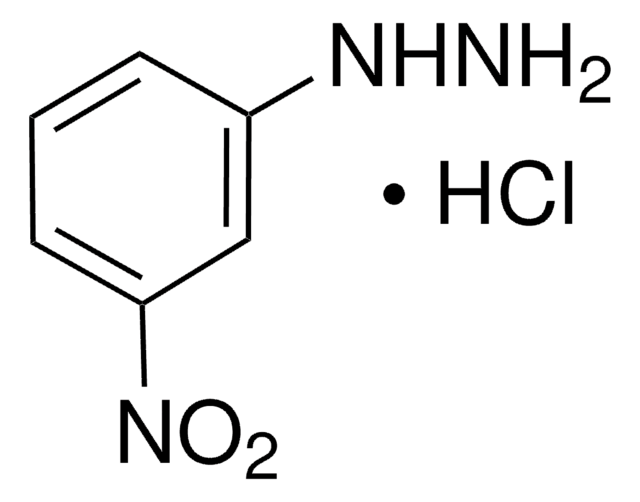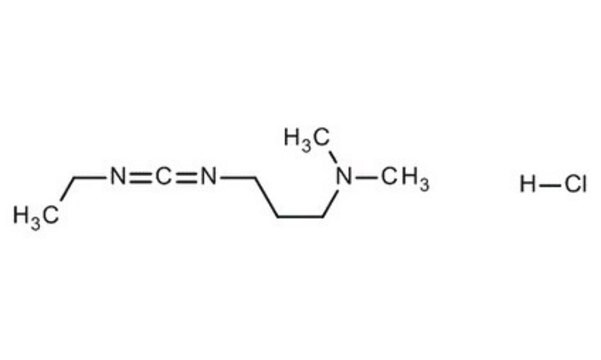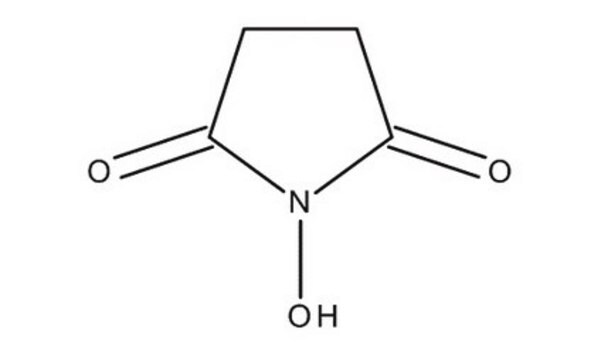Kluczowe dokumenty
03449
N-(3-Dimethylaminopropyl)-N′-ethylcarbodiimide hydrochloride
≥99.0% (AT)
Synonim(y):
N-Ethyl-N′-(3-dimethylaminopropyl)carbodiimide hydrochloride, EDAC, EDC, EDC hydrochloride, WSC hydrochloride
About This Item
Polecane produkty
Poziom jakości
Próba
≥99.0% (AT)
Formularz
powder
metody
bioconjugation: suitable
mp
110-115 °C (lit.)
112-116 °C
rozpuszczalność
H2O: soluble 0.2 g/L
temp. przechowywania
−20°C
ciąg SMILES
Cl.CCN=C=NCCCN(C)C
Cl.CCN=C=NCCCN(C)C
InChI
1S/C8H17N3.ClH/c1-4-9-8-10-6-5-7-11(2)3;/h4-7H2,1-3H3;1H
Klucz InChI
FPQQSJJWHUJYPU-UHFFFAOYSA-N
Szukasz podobnych produktów? Odwiedź Przewodnik dotyczący porównywania produktów
Opis ogólny
Ponadto EDAC HCl służy jako mostek biomolekuł, działając jako środek sieciujący, który łączy reaktywne aminowo estry NHS biomolekuł z grupami karboksylowymi. Technika ta okazuje się nieoceniona w koniugacji białek, umożliwiając tworzenie cząsteczek hybrydowych o nowych właściwościach i funkcjach. Podstawowy mechanizm obejmuje reakcję EDAC HCl z grupą karboksylową, tworząc niestabilny związek pośredni, który aktywnie poszukuje partnera aminowego. Delikatna równowaga tej reakcji podkreśla znaczenie optymalizacji warunków dla skutecznej koniugacji. Pomoc N-hydroksysukcynimidu (NHS) dodatkowo zwiększa możliwości EDAC HCl, stabilizując związek pośredni i umożliwiając dwuetapowe procedury koniugacji. Ta dodatkowa funkcja zapewnia większą elastyczność i kontrolę, szczególnie w przypadku złożonych biomolekuł.
Zastosowanie
Działania biochem./fizjol.
Cechy i korzyści
Inne uwagi
produkt podobny
Hasło ostrzegawcze
Danger
Zwroty wskazujące rodzaj zagrożenia
Zwroty wskazujące środki ostrożności
Klasyfikacja zagrożeń
Acute Tox. 3 Dermal - Acute Tox. 4 Oral - Aquatic Acute 1 - Aquatic Chronic 1 - Skin Irrit. 2 - Skin Sens. 1 - STOT RE 2 Oral
Organy docelowe
Stomach,large intestine,lymph node
Kod klasy składowania
6.1C - Combustible acute toxic Cat.3 / toxic compounds or compounds which causing chronic effects
Klasa zagrożenia wodnego (WGK)
WGK 3
Temperatura zapłonu (°F)
Not applicable
Temperatura zapłonu (°C)
Not applicable
Środki ochrony indywidualnej
dust mask type N95 (US), Eyeshields, Gloves
Wybierz jedną z najnowszych wersji:
Masz już ten produkt?
Dokumenty związane z niedawno zakupionymi produktami zostały zamieszczone w Bibliotece dokumentów.
Klienci oglądali również te produkty
Produkty
Carbodiimide-mediated peptide coupling remains to the most frequently used technique.
Professor Aran (Claremont University, USA) thoroughly discusses the engineering of graphene based materials through careful functionalization of graphene oxide, a solution processable form of graphene.
Nasz zespół naukowców ma doświadczenie we wszystkich obszarach badań, w tym w naukach przyrodniczych, materiałoznawstwie, syntezie chemicznej, chromatografii, analityce i wielu innych dziedzinach.
Skontaktuj się z zespołem ds. pomocy technicznej









![1-[3-(Dimethylamino)propyl]-3-ethylcarbodiimide methiodide](/deepweb/assets/sigmaaldrich/product/structures/414/134/4eb9c126-d7f9-4e12-9e3a-95cb077824fd/640/4eb9c126-d7f9-4e12-9e3a-95cb077824fd.png)


